Employee experience is one of the main priorities for organizations across the world. CEOs, Human Resources, Internal Communications, Talent Acquisition, Talent Management, and other departments are all focused on improving their people’s working experiences.
The current world situation and the emergence of remote work are significantly impacting employees’ work-life balance, and many employees expect their employers to support them through these turbulent times.
In this guide, you will learn about:
- What is Employee Experience
- Why Employee Experience Is Important
- How to Improve Employee Experience
- Employee Experience FAQs
What is Employee Experience
Employee experience is a discipline that has not been defined clearly. Many people confuse employee experience with employee engagement, motivation, satisfaction, and similar aspects of HR.
Even though employee experience is still to be clearly defined, there are a few existing definitions that provide a good overview of what employee experience really is.
One of the simplest and globally-adopted definitions is the one from Gallup:

Josh Bersin’s EX definition goes a little bit deeper, and it emphasizes that employee experience is not only HR’s responsibility anymore:
“Employee experience is a company-wide initiative to help employees stay productive, healthy, engaged, and on track. It’s no longer an HR project. It is now an enterprise-wide strategy, often led by the CHRO in partnership with the CIO. And it deals with all the day-to-day issues employees face at work.”
📚 Related: Employee Engagement Guide
Why Employee Experience Is Important
Employee experience directly impacts employees’ engagement in the workplace. Better employee experience makes people more motivated to do their best which ultimately impacts their productivity levels.
However, on average, only 53% of employees globally report feeling engaged at work, and this is the reason why improving the employee experience is now one of the main business priorities for organizations across the globe.
The current pandemic is also significantly influencing Human Capital Management, and many companies are now adjusting their HCM strategies in a way to help them keep their employees’ experience, morale, and productivity as high as possible.
In research by Deloitte, nearly 80% of executives rated employee experience very important (42%) or important (38%), but only 22% reported that their companies were excellent at building a differentiated employee experience.
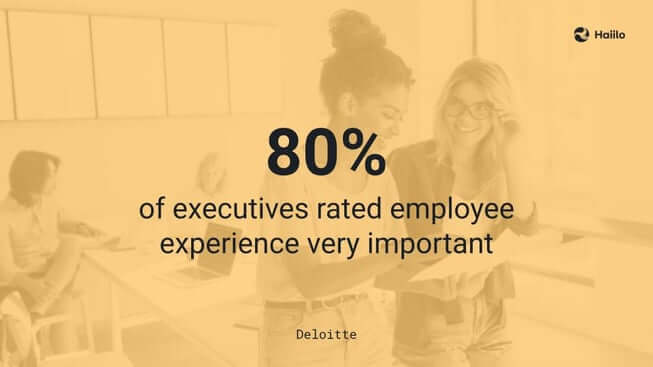
So let’s take a closer look into how various employee experience areas can impact the overall business results.
Better employee productivity and more revenue
Increasing employee productivity is a big challenge for many organizations. According to Deloitte, productivity in the United States is rising by only about 1% annually, even as employees are working more hours.
On the other side, happy employees with positive employee experience are up to 20% more productive at work, while unhappy employees take 15 more sick days each year than the average worker.
Another research proved that companies with engaged employees pull in 2.5x more revenues compared to competitors with low engagement levels, and organizations with a highly engaged workforce are 21% more profitable than those with poor engagement.
It is inevitable that poor working experience significantly impacts one’s engagement and productivity at work. Organizations that understand the value of investing in employee experience design also see higher employee productivity levels.
Lower employee turnover
Relationships between managers and employees highly impact the overall employee experience in the workplace, and poor relationships are often the biggest reason for low employee retention rates.
Employees whose managers consistently acknowledge them for good work are 5x more likely to stay at the company, and 75% of employees who voluntarily left their jobs said it was because of their manager, not the job itself.
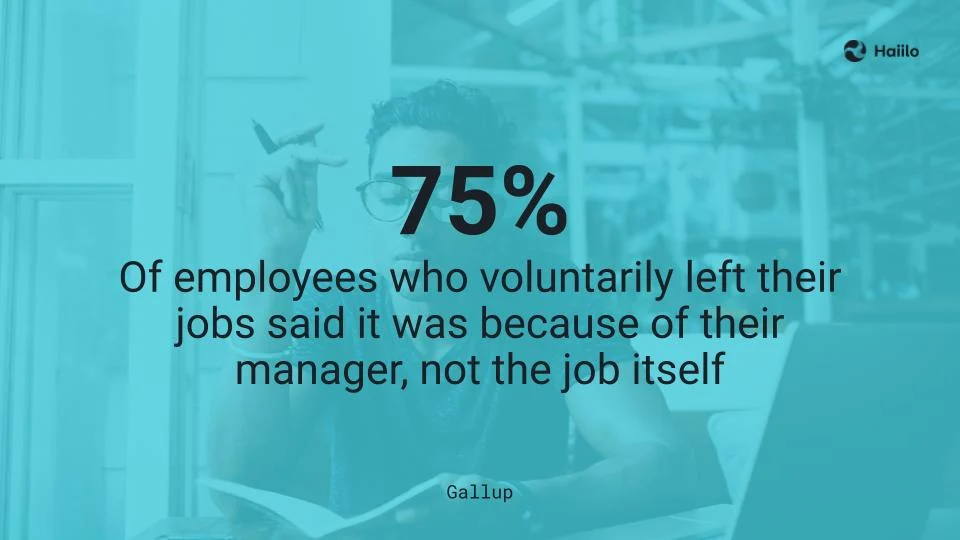
Training managers to be better leaders and empowering them to enable their people for success should be one of the main priorities for organizations looking to improve their employees’ experience and boost the overall workplace culture.
📚 Also learn about the importance and best practices for driving empowerment in the workplace.
Better customer experience and satisfaction
Just as customer success teams have moved beyond customer satisfaction to look at total customer experience, so is HR refocusing its efforts on building programs that continuously improve the entire employee experience.
But how are employee experience and customer experience connected?
Research shows that companies that excel at customer experience have 1.5 times more engaged employees than companies with a record of poor customer experience.
Consequently, 51% of business leaders are planning to create individualized employee experiences comparable to consumer experiences in the next two years. It’s pretty clear that companies who invest in employee experience can see a higher ROI than those who don’t.
Improved employee wellbeing
Wellbeing is at the heart of the employee experience because caring about our employees’ wellbeing creates mutual commitment and emotional connections.
A report from Gallup defines wellbeing along with five elements (career, social, financial, physical, and community) that can help people achieve what they call “holistic wellbeing.” People who are satisfied in these areas are more likely to be engaged, innovative, collaborate, and are ready to learn new things.
For employers that want to shift their employee experience and build employee-centered cultures, they should start by focusing on their employees’ wellbeing.
🎧 Tune in and listen to our podcast: Your Employee Engagement is Low. What to Do About It?
How to Improve Employee Experience
Workplace trends are continuously changing, and those changes can be hard to keep up with. Today’s employers are being tasked with the job of attracting and retaining talent within their organizations.
To keep up with the emerging HR trends, innovative companies are rapidly taking steps towards a new vision of the traditional role of HR, leadership, and internal communications.
In essence, shaping a positive workplace experience means building organizations irresistible to employees while understanding various moments and experiences throughout employees’ entire career journeys.
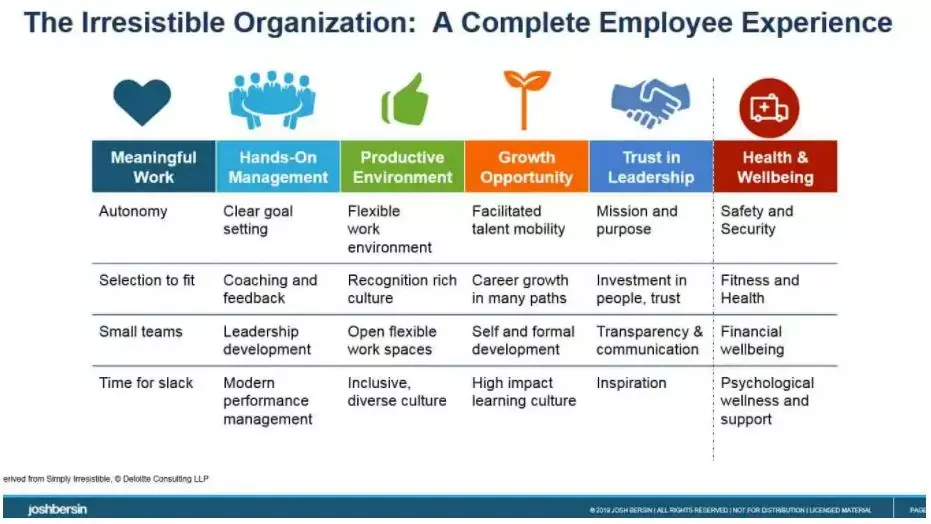
So let’s take a look into what shapes a good employee experience in the workplace.
📙 Also read: 12 Talent Management (TM) Tips for Navigating Turbulent Times.
Meaningful work
Even though today’s workplaces are highly multigenerational, younger generations such as Millennials and Gen Z employees make the majority of today’s workforce. These generations care about doing meaningful work that fits their personal beliefs. It is important for them to have autonomy and work with ambitious teams and colleagues.
Supportive management
Employee-manager relationships are one of the main factors impacting employee experience in the workplace, and managers account for over 70% of the variance in employee engagement.
In order to motivate their people, managers need to:
- Give clear directions and goals
- Communicate frequently and openly to build trust
- Provide mentorship and continuous feedback
- Encourage bottom-up feedback
- Implement scalable and modern performance management activities
- Actively listen to employees and act based on results
📙 Also read: The Ultimate Management Communication Guide.
Positive and productive work environment
Today, more than ever before, employees expect a flexible work environment. Because of the emergence of COVID-19, many workers don’t consider remote work as a nice-to-have benefit anymore – they consider it as a must-have.
Besides flexibility, internal communications also play a critical role in building a positive and productive workplace culture. Open, transparent, frequent, and honest workplace communications can go a long way in boosting employee morale, engagement, and job satisfaction.
Building a culture in which employees feel appreciated for what they do is an absolute prerequisite for organizations that aim to improve their employees’ experience. Yet, only 51% of workers are satisfied with the recognition they received after a job well done.
Growth opportunities
Based on research, 87% of Millennials say professional development or career growth opportunities are very important.
Even though compensation is still the leading motivator for employees, it is just a short-term employee engagement and retention strategy. Employees want other types of benefits that can empower them to grow and develop their careers, which is why learning and development should always be an important part of every employee-centered workplace culture.
Trust in leadership
Inspiring leadership is often what separates successful from not-so-successful organizations. Leadership communications are critical for building trust in the workplace and aligning employees with the organization’s vision, mission, and core company values.
During this pandemic, we learned about the importance of authenticity and honesty when it comes to leadership. Great leaders are the ones who always serve as role models to all their employees.
To prove the importance of leadership trust, here is a great statistic by Gallup:
“96% of engaged employees trust the people who run their companies, compared to only 46% of actively disengaged employees.”
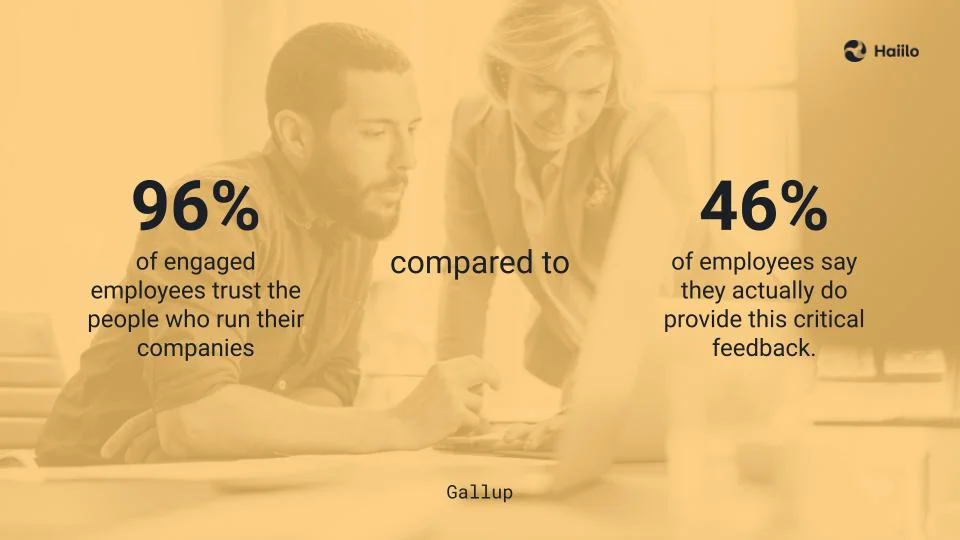
Therefore, leadership is one of the most important and most impactful aspects of employee experience!
Health and wellbeing
Employee safety, mental and physical wellbeing have become priorities for companies across the world. People are scared, worried, and many frontline employees are constantly at risk of getting infected with the new virus.
As a consequence, employees’ morale is dropping, their private and personal lives are in disbalance, and they are experiencing high-stress levels.
For that reason, employee wellbeing is now considered one of the most important pillars of employee experience in the workplace. Employees expect their employers to provide safe and supportive working environments.
A recent study shows that 69% of workers claimed COVID-19 times were the most stressful times of their entire professional career. To mitigate the consequences of the current situation, many employers are implementing employee wellbeing initiatives in the workplace.
Cross-organizational collaboration and communication
The silo effect happens when groups within your organization become separate and distinct “silos”. When this happens, teams collaborate and communicate with each other but are cut off from the rest of the organization. As cross-functional collaboration is becoming increasingly important these days, many organizations are now investing in new employee communications solutions to help their people stay connected.
Unfortunately, according to research by Queens University of Charlotte, 39% of employees still believe that there isn’t enough collaboration between people in their organization.
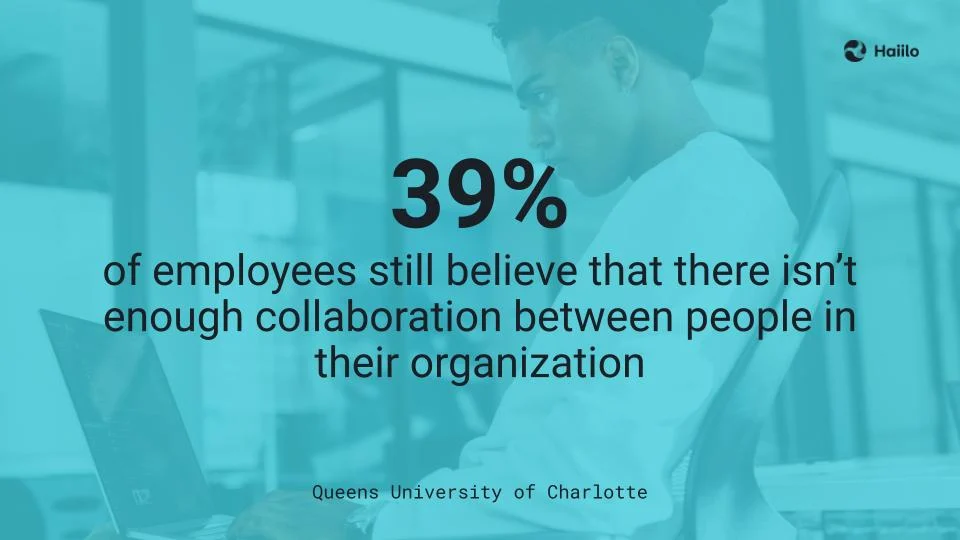
Let’s be honest: Your employees think the same
Try Haiilo today to get better employee collaboration quickly
But how does this influence employee experience?
When there is a lack of cross-functional communication, redundant work is inevitable. When multiple employees work on similar initiatives without knowing what their colleagues are working on, frustrations increase and employee productivity drops significantly.
📚 Related: 9 Ways to Combat Employee Turnover
Employee Experience FAQs
Let’s take a look at some frequently asked questions about employee experience.
What is the difference between employee experience and employee engagement?
Employee experience and employee engagement are two terms that many people still use interchangeably. While employee experience consists of all the moments and interactions employees have with their organizations, employee engagement is the level of effort employees invest to perform well. In essence, the overall employee experience in the workplace impacts how engaged employees are at work.
Organizations that focus on creating positive employee experiences throughout their career paths are the ones that also enjoy higher employee engagement and retention rates.
Who is responsible for ensuring a positive employee experience?
Traditionally, it was mostly on HR to ensure that employees are motivated and satisfied at work. Today, many other individuals and departments play an important role in shaping positive employee experience:
- Managers play a significant role in driving positive experiences for their employees, enabling employees for success, and making team communication and collaboration seamless.
- HR departments are responsible for ensuring attractive and motivating benefits and creating a positive organizational culture.
- Internal communications departments take a role in making sure that employees are well informed and have seamless access to important information.
- IT professionals are responsible for finding and implementing the right workplace technology, and making employee data safe and secured.
- CEOs and other C-level executives play an important role in keeping the workforce inspired by clearly communicating the organization’s mission and vision.
How does remote work impact employee experience?
Remote work has a big impact on employee experience. While some workers prefer remote ways of working, others are struggling to adjust and achieve the right balance between their private and professional lives.
A random sample of 1,099 US workers conducted by SHRM shows that 41% of U.S. employees feel burnt out from work, while another 23% report feeling depressed. This survey of the mental health of workers was conducted under the pandemic lockdown and found employees struggling with negative emotions, concentration, and feeling unmotivated to do their job.
What is digital employee experience (DEX)?
Digital employee experience is the experience employees have with the technology they use in their organizations. As today’s workforce highly depends on technology, DEX plays a big role in making employees more successful and happier with their jobs.
Furthermore, integrated workplace technology is becoming one of the main priorities for IT departments responsible for implementing and managing workplace tech stacks.
💡 Also learn about what are employee engagement apps and why every organization needs one.
Who are some employee experience influencers worth following?
Here is the list of some of the well-known EX influencers:
What are some of the best employee experience blogs to follow?
Here is the list of some of the best EX blogs to follow:
What are some inspiring employee experience quotes?
“In a world where money is no longer the primary motivating factor for employees, focusing on the employee experience is the most promising competitive advantage that organizations can create.”
“Employee experience doesn’t need to replace engagement. The two can actually work together, and in fact, they have to.”
-Jacob Morgan, keynote speaker, futurist, and author of The Employee Experience Advantage
“We in HR have to get away from the idea that we alone own the employee experience. We can’t.”
-Josh Bersin, Principal at Josh Bersin Academy
“The prevailing factor to drive employee engagement, and therefore create exceptional employee experiences, can be summed up in one word: Impact”
-Lior Arussy, Investor, Strategy Accelerator, Creative Catalyst, Author, Speaker
“[I]t’s time to shift our focus from our current path of engagement into what today’s workforce is desperately seeking: a career that’s more than just a job — an experience.”
-Melissa Anzman, The Employee Experience Solution: Transform Employee Engagement, Improve Workplace Culture, and Drive Results
Looking for an Employee Experience Platform?
If you are looking for a modern, intuitive, and flexible employee experience platform to improve your employee engagement, motivation, retention, and overall workplace experience, schedule a Smarp demo.









